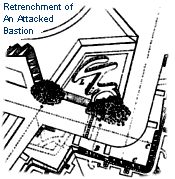 A
fortified line or work constructed within a larger fortification. Retrenchments
could be constructed as an element in the original design of a fortification
or thrown up rapidly after an attacking force opened its trenches in an attack
by regular and the point of attack became evident. Retrenchments could also
be hastily constructed in rear of a rampart or parapet after the attacking
force's breaching batteries opened their fire. Their primary purpose was
to provide a defensible protective barrier behind the main line of rampart
and parapet that would allow a garrison to continue its defense after the
main work had been breached. A
fortified line or work constructed within a larger fortification. Retrenchments
could be constructed as an element in the original design of a fortification
or thrown up rapidly after an attacking force opened its trenches in an attack
by regular and the point of attack became evident. Retrenchments could also
be hastily constructed in rear of a rampart or parapet after the attacking
force's breaching batteries opened their fire. Their primary purpose was
to provide a defensible protective barrier behind the main line of rampart
and parapet that would allow a garrison to continue its defense after the
main work had been breached.
 Retrenchments
in permanent fortifications could be positioned behind and commanding the
curtain to add artillery positions to defend the interior of the demi-lune
in front of the curtain and the interiors of collateral bastions. Cavaliers
could also be constructed within bastions to provide a second tier of fire
from the bastion faces and to seal breaches on the faces or at the flanked
angle. When a breach in a bastion face seemed imminent a line of parapet
could be thrown up that extended from shoulder to shoulder in the form a
small tenaille or bastion front. In field fortifications a retrenchment could
be as simple as a second Retrenchments
in permanent fortifications could be positioned behind and commanding the
curtain to add artillery positions to defend the interior of the demi-lune
in front of the curtain and the interiors of collateral bastions. Cavaliers
could also be constructed within bastions to provide a second tier of fire
from the bastion faces and to seal breaches on the faces or at the flanked
angle. When a breach in a bastion face seemed imminent a line of parapet
could be thrown up that extended from shoulder to shoulder in the form a
small tenaille or bastion front. In field fortifications a retrenchment could
be as simple as a second
 line of parapet
constructed immediately in rear of an advanced line or a line of parapet
that cut across the gorge of a salient section of a work. line of parapet
constructed immediately in rear of an advanced line or a line of parapet
that cut across the gorge of a salient section of a work.
|